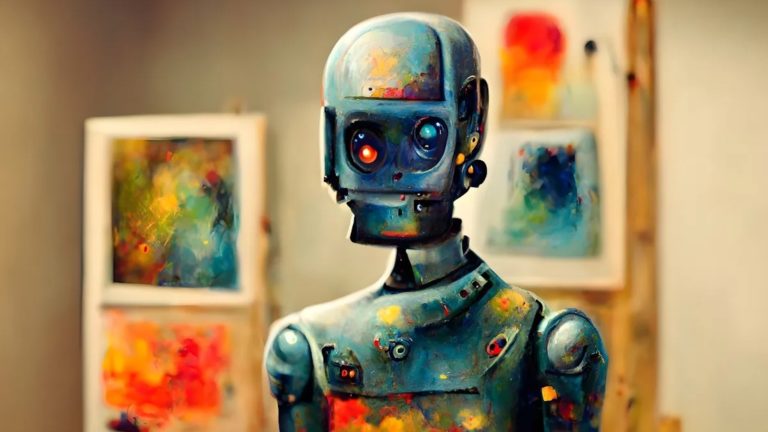Introduction to AI Art
AI art has become extremely popular on social media platforms, and the growing concern is that AI generated art may become a threat to human creativity and fine arts in general. The programs use the works of human artists, which equally prompts copyright concerns. For some, this movement into the Digital Age, with artificially produced works, brings with it a concern that there will be less room for artists to produce original works in the marketplace, eventually making human artists obsolete.
- There has been a significant increase in use of artificial intelligence in art.
- Artists and aesthetes have legitimate growing concerns.
- In this post, we’ll explain what AI generated art is, why AI art is important, and explain how it is not a threat to human creativity or the fine arts.
What is AI Art, and Why Does it Matter?
Artificial intelligence generated art, also known as AI art, is literally any art generated by artificial intelligence programs. This technological advancement certainly calls into question the subjective-objective definitions of what ‘art’ is and what it is to become. Today, AI art is all over the media and online. The current popular work involves people typically downloading an app on their phone, taking multiple pictures of themselves, and like magic the software generates numerous images in the person’s likeness in various styles of artistic expression. AI art also consists of text-to-image processing, which enables someone to simply type in whatever they wish and the software will generate a corresponding image. With each of these forms of AI art, the respective generators source various works of art online from human artists and other AI generated work to create the final product.
The benefits of AI art are exponentially growing and what is to be developed from this evolving software is yet to be seen. AI art is helping the layperson create an image they appreciate, either for free or at a lower cost than had they hired an artist. AI art is assisting curators generate completed images for unfinished or damaged works. AI art is being used by curators and historians to analyze art for authentication while detecting forgeries. AI art is bringing facial recognition technology to a more advanced digital frontier. AI art is helping artists think outside of the norm while creating new concepts and styles for artists themselves. AI art is deepening learning capacity in Generative Adversarial Networks and Neural Style Transfer capabilities, but more advanced machine learning than standard data capture used in CAPTCHA. With these important benefits and more, new technologies, targeted marketing techniques, and manufacturing will be created.
How to Know AI Generated Art Is Not a Threat to Human Creativity
Perhaps the backlash is more from the perspective of Luddites and those generally fearful of technology replacing jobs. It is understandable for some industries to be concerned about this. In contrast, however, we see technological advancements create more jobs overall, and this natural occurrence incentivizes greater targeted marketing and further creativity.
Ideas and the creative, actualized, application of ideas are what change art and technology. These utilized ideas are what prompt changes in the applied technology, software, or the AI and the art it creates. This is a response to changes in human needs and desires. Just as art has changed in the past with human advancement, we will continue to see changes, but not the total reliance on a particular medium.
There have been many innovations throughout art history that changed art forever. Artists no longer draw on cave walls with charcoal or make their own paint out of necessity. There are more art mediums and colors today than 200 years ago, yet art continues to thrive without wishing away the progress already made. With progress in travel, shipping, trade, mining, introduction of new materials, and packaging processes, it made the cost of paint significantly cheaper and more abundant to where artists could more freely practice painting. These changes, and many others, are what led to Impressionism and a plethora of styles of art. Throughout this development, it was human ideas and action that led to creative innovation, and made it easier for nearly anyone to become an artist instead of a limited few.
Artificial intelligence generated art will be no different in that other mediums and styles will continue to exist and to be used. AI art will still rely on human input and response, creative thought and consideration, and human action within the marketplace of ideas to implement them within the anthroposphere. AI generated art can possibly increase state powers, especially in the realm of surveillance and facial recognition, while pressing towards a centralized technocracy. However, the AI art software and respective technology used neither reads the entire market nor knows the market’s entirety. Just as no human has that omniscient or omnificent capability, no technology has these super powers, and changes will naturally happen.
Final Note
Ultimately, from the AI technology to art in general, from the input of definitions and output of products, all require human minds and creativity because each spring from the human mind and are to be received by the human mind. Thus, each element is restricted to its adaptation for human consumption and production thereof.














[…] has come to realize. It has been extremely difficult to pinpoint all of the fake accounts because artificial intelligence bots are currently outsmarting much of the software used and the people conducting the […]